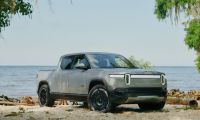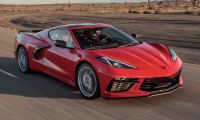Mazda has a long history of developing and utilizing rotary engine technology in its cars. The Wankel rotary engine is a unique powertrain that uses a spinning triangular rotor to perform the functions of intake, compression, combustion, and exhaust. It has fewer moving parts, runs smoother and slower, yet delivers more power than a conventional piston engine. However, the rotary engine's poor reliability and efficiency led to its phase-out in 2012.
Now, Mazda is bringing back the rotary engine in the form of a range-extending generator used in its MX-30 electric vehicle, but about 10 years ago hopes were deem for the revival of this Mazda engine. This new rotary-powered, electrified powertrain is called the e-Skyactiv R-EV and is the only one of its kind on the market. The rotary engine powers the generator system and is positioned on the same axle as the electric motor. It never actually powers the wheels, though, like it does in actual hybrid vehicles, where both the combustion engine and electric motor provide propulsion.
One of the reasons Mazda chose the rotary engine for the MX-30 range extender is its ability to achieve a specific output with a physically smaller power unit. The e-Skyactiv R-EV powertrain is designed to offer a practical and seemingly effective method to boost the range of EVs. It also features an exhaust gas recirculation (EGR) system for further efficiency gains at low rpms as well as reducing its emissions.
The electric motor in the e-Skyactiv R-EV powertrain is paired with a 17.8 kWh lithium-ion battery, like you would find in any EV. That's almost exactly half the size of the 35.5 kWh battery pack found in the Mazda MX-30 EV without the range extender. According to Mazda, this new rotary engine is lighter and more efficient than its predecessor. With its small 0.83-liter displacement, this direct-injected engine runs a high compression ratio to achieve a peak output of 73 hp.
The MX-30 e-Skyactiv R-EV was introduced for the 2022 model year and is Mazda's first battery-electric vehicle. The only US state where it's currently available is California, where it's sold in low volumes. Critics' most consistent complaint about the MX-30 is its low electric-only range, which caps out at just 100 miles. Mazda sought to fix this for the 2023 model year by adding the rotary range extender engine to the powertrain, thereby creating the MX-30 e-Skyactiv R-EV. Unfortunately, this MX-30 variant is only on sale in Europe. Interested buyers in the US will have to wait and see if the MX-30 e-Skyactiv R-EV is destined to be stateside.
Mazda has left details about the total range of the MX-30 e-Skyactiv R-EV rather vague. According to the automaker, this MX-30 variant has an approximately 53-mile battery electric driving range, less than the BEV model. The rotary engine has a 13-gallon gas tank for backup. With a full charge of the battery and a full tank, Mazda estimates that the MX-30 R-EV should be good for a range of over 400 miles, calculated on the WLTP test cycle.
Mazda says the MX-30 e-Skyactiv R-EV supports compatibility for both normal and fast charging. The automaker hasn't released official charging information, but for comparison, the approximate charging time for the BEV MX-30 can be less than an hour using a level 3 fast charger, or several hours with standard charging. The MX-30 R-EV also provides up to 1,500 watts of power, giving it vehicle-to-load charging.
Mazda's e-Skyactiv R-EV powertrain is a significant step forward in electric vehicle technology and range-extending capabilities. The company's decision to use the rotary engine as a range extender in its first EV, the MX-30, shows that the company is not afraid to innovate and think outside the box. The e-Skyactiv R-EV powertrain offers practical benefits in terms of weight, size, efficiency, and performance.
The rotary engine's unique design and simplicity make it an ideal range extender. The engine's small size, combined with its high power output, makes it an excellent option for boosting the range of electric vehicles. Additionally, Mazda's exhaust gas recirculation system improves efficiency and reduces emissions, making it an environmentally-friendly powertrain.
Mazda's e-Skyactiv R-EV powertrain is an excellent example of how innovation can be used to solve problems in the automotive industry. The range-extending capabilities of the rotary engine are a perfect solution to the limitations of current EVs. As electric vehicle technology continues to evolve, it is likely that we will see more innovative solutions like Mazda's e-Skyactiv R-EV powertrain emerge.
Mazda's decision to revive the rotary engine as a range extender in its EVs is a bold move that has paid off. The e-Skyactiv R-EV powertrain offers practical benefits in terms of weight, size, efficiency, and performance, and is an excellent example of how innovation can be used to solve problems in the automotive industry. As the popularity of EVs continues to grow, it will be interesting to see how Mazda and other automakers continue to innovate and improve EV technology.
Mazda's Future Plans for Rotary Engine Technology. While the current application of the rotary engine in the MX-30 e-Skyactiv R-EV is as a range extender, Mazda has plans to continue developing its rotary engine technology for future applications. In fact, Mazda has been working on a new rotary engine that can run on both gasoline and liquefied petroleum gas (LPG), known as the Skyactiv-R.
Mazda has stated that the Skyactiv-R engine is not meant to replace the current e-Skyactiv R-EV powertrain but rather to complement it. The Skyactiv-R engine is being developed with the goal of achieving a higher level of performance while also being more eco-friendly. While specific details on the Skyactiv-R engine are still unknown, Mazda has stated that it will use a turbocharger and be able to run on LPG, which has lower carbon emissions than gasoline.
Mazda has also hinted at the possibility of using rotary engine technology in future hybrid vehicles, where the rotary engine would serve as a range extender similar to its current application in the MX-30 e-Skyactiv R-EV. This would allow Mazda to combine the benefits of a hybrid powertrain, such as improved fuel efficiency and reduced emissions, with the unique characteristics of the rotary engine, such as its smoothness and high power output.
Mazda's decision to revive its rotary engine technology as a range extender for the MX-30 e-Skyactiv R-EV is a bold move that highlights the automaker's commitment to innovation and sustainability. While the use of a rotary engine as a range extender may seem unconventional, Mazda's e-Skyactiv R-EV powertrain has proven to be effective in extending the range of its EVs.
The e-Skyactiv R-EV powertrain's design is unique in the market, with its rotary engine powering the generator system and positioned on the same axle as the electric motor. With a small 0.83-liter displacement and a high compression ratio, the rotary engine achieves a peak output of 73 hp, while an EGR system further improves efficiency and reduces emissions.
Although the MX-30 e-Skyactiv R-EV is currently only available in limited markets, Mazda's plans for the future of its rotary engine technology are promising. With the development of the Skyactiv-R engine and the potential use of rotary engines in future hybrid vehicles, Mazda is poised to continue its legacy of innovation and sustainability in the automotive industry.
Armen Hareyan is the founder and the Editor in Chief of Torque News. He founded TorqueNews.com in 2010, which since then has been publishing expert news and analysis about the automotive industry. He can be reached at Torque News Twitter, Facebok, Linkedin and Youtube.











